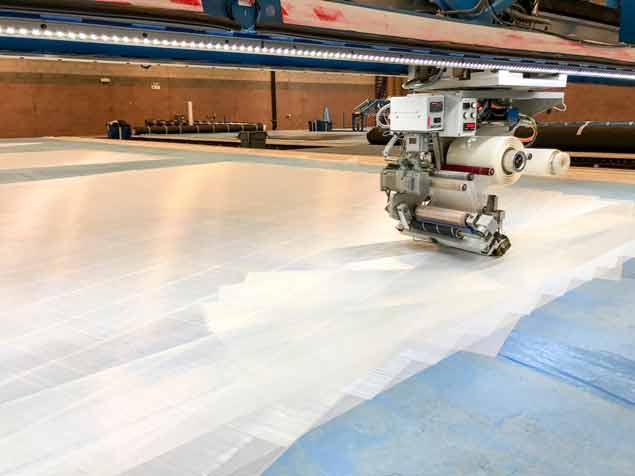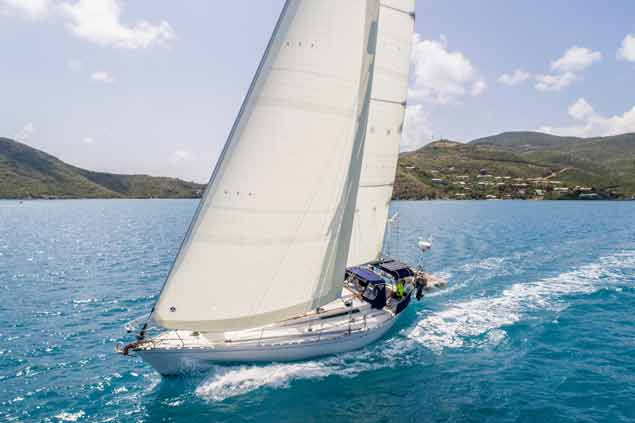Displaying items by tag: 3Di NORDAC
North Sails 3Di NORDAC Claims Pittman Innovation Award
North Sails 3Di NORDAC, already recognised as game changing cruising technology, has claimed yet another coveted prize. The revolutionary polyester sail, designed for small to medium sized cruising boats, was yesterday announced as a winner of SAIL Magazine’s renowned Pittman Innovation Awards. The cloth recently featured on Afloat.ie here.
Since 3Di NORDAC was launched in June 2017, the sail has seen success with cruisers and industry experts, claiming awards and stellar sales in a short space of time, with more than 1600 orders placed since being introduced. The SAIL judges recognized that 3Di NORDAC offers the wider sailing community the unique 3Di technology developed on the race course: “With its new 3Di NORDAC sails, North has combined the great cost-effectiveness and durability of traditional sails with the 3Di process by building them entirely in polyester, with polyester filaments set in polyester resin in the 3Di structural tape ,” said SAIL editor Charles J. Doane. “The result is an affordable all-polyester sail that is lighter, less stretchy, more durable and more mildew-resistant than traditional woven polyester sails - a win-win for cruising sailors everywhere.”
Commenting on the award victory, North Sails CEO Dan Neri added, “In 2015 we saw a real opportunity to create product differentiation in the cruising market and we felt confident we had developed something special with 3Di NORDAC. We are pleased by the response from the cruising community.”
3Di NORDAC is a familiar-looking white sail, boasting stronger, smoother, longer lasting shape, and priced to compete within the cruising market. We would like to thank the SAIL Pittman Innovation Awards for celebrating this great product. Controlling your sail power with responsive sails is the hallmark of the North Sails cruising experience. 3Di NORDAC sails deliver this experience with less heel, less helm, less leeway and lighter, more easily-handled Dacron sails than ever before. 3Di NORDAC product does this without sacrificing the durability that is critically important to cruising sailors.
Many sailmakers might argue that Aramid or Dyneema yarn deliver a “better” sail, and that polyester is too low tech and offers no interesting properties. North Sails believes polyester remains the right material for the cruising market. Sail distortion of any type - stretch, compression, shear or shrink - has a negative effect on sail performance. Most sails concentrate on resisting loads in the stretch (tension) direction.
Ounce for ounce, 3Di sails have significantly more resistance to stretch than any other sail made in the world today. Polyester is high durability (UV resistant, flex, abrasion, toughness), soft, lightweight and forgiving to handle. Sailors enjoy the rugged external rip stop surface of 3Di NORDAC, zero risk of delamination, perfect sail shape and integrated reefs for better reefed sail shape.
3Di NORDAC: A Smarter Way to Make Durable, Affordable, High Quality Cruising Sails
North Sails, the worldwide leader in sailmaking technology is pioneering a revolution in Dacron sailmaking. For thousands of years, sailcloth has been made by the ancient process of weaving fibers into a finished material. For over 60 years, Woven Polyester (Dacron) has proven to be the fiber of choice for cruising sailcloth – providing low cost and structurally durable sails. Today, Polyester remains a nearly perfect fibre for cruising sails due to its strength and environmental stability.
The problem with Woven Dacron sailcloth however, is that it fails to provide true value to cruising sailors. Woven sails lose their shape - far before their structural integrity is compromised. In short, their structural life and the performance life are out of balance. Cruising sailors are overpaying for poor performance and they are not achieving the enjoyment of experience they can have when their boats sail better through the water. Controlling your sail power with responsive sails is the hallmark of the North Sails Cruising Experience.
3Di NORDAC sails deliver this experience with less heel, less helm, less leeway and lighter, more easily handled dacron sails than ever before. 3Di NORDAC does this without sacrificing the durability that is so important to cruising sailors - by better balancing the structural and usable life span.
 To create a North sails 3di sail woven cloth is calendared with high pressure rolling
To create a North sails 3di sail woven cloth is calendared with high pressure rolling
UNIQUE TO YOU
North Sails is unique in its position of offering cutting edge sail technology to a wide range of sailors and boats. Born from the America’s Cup, 3Di is available to Grand Prix Around-The World Ocean Racers and family cruisers alike.
COMPOSITE CONSTRUCTION
3Di composite construction is unique in the sailmaking industry. Like other high-performance composite structures, only fiber and adhesive are in these sails. Spread filament prepreg tapes are interleaved, in varying numbers of layers and a multiplicity of orientations to best handle both the tension loads and the compressive forces in any given sail. The ability to precisely align fibers and vary fiber density throughout the sail membrane, optimizing the sail structure for the anticipated loads, is the essential advantage of composite construction. 3Di does not contain Mylar film, scrims, or taffetas. 3Di is not subject to the lamination problems of string sails, making them more durable and long lasting.
 The sail’s shape and durability are permanently locked into the rigid airfoil that is customized to the user’s sailing preferences
The sail’s shape and durability are permanently locked into the rigid airfoil that is customized to the user’s sailing preferences
PERSONALISED SHAPE
North Sails is the only sailmaker in the world to build sails on full-sized 3D molds, inflated to the sails’ precise flying shape. Heat and vacuum pressure are then applied, consolidating the composite structure. The sail’s shape and durability are permanently locked into the rigid airfoil that is customized to the user’s sailing preferences
COMMITTMENT TO QUALITY
Batten pockets, reefs and patches are integrated into the tape structure. Finishing on a 3Di sail is minimal. Edge tapes, corner strapping and hardware are sewn by hand on the loft floor with careful attention to detail. All North sails are manufactured in wholly-owned facilities. Our Blue Book Standards for strict construction, material and labor standards result in consistency for all of our products. 3Di quality and North’s reputation for consistency has won North Sails exclusive supplier status to the 35th America’s Cup and the Volvo Ocean Race 2017-18.
3Di APPLIED
In addition to use in sails, North Thin Ply Technology has been adopted in a variety of high tech manufacturing applications. TPT flew around the world on the first non-stop solar powered aircraft and can be found in advanced golf shafts, Southern Spars masts and booms, and F1 motorcars. When using 3Di sails, you are joining an elite group who has chosen the world’s leading composite technology.
More about 3Di technology
THE NEW STANDARD FOR PERFORMANCE AND DURABILITY
North Sails 3Di exemplifies outstanding value with industry leading shape holding and a longer service life compared to other sailmaking technologies. Proprietary engineering and construction methods allow 3Di sails to maintain their shape to an unprecedented level. Superyachts now use one set of 3Di sails for racing, cruising and deliveries. Volvo Ocean Race teams trust one mainsail for 35,000+ miles around the world; they formerly used two or three string laminate sails. Circumnavigators are using 3Di sails for multiple laps. Do the math, and you’ll find that 3Di sails have a lower cost of ownership than any other sails in the world.
ONLY THE ESSENTIALS
3Di sails are significantly stronger and lighter than our competitor’s laminate string sails when made of comparable materials. Filaments are the elemental form of fibers. What we think of as a yarn used in traditional sailcloth and string sails are in fact a twisted bundle very small filaments, each less than the diameter of a human hair. Using filaments instead of yarns in sail constructions allows better exploitation of the fiber properties.
For further information about 3Di NORDAC visit northsails.com or download a press pack below
























